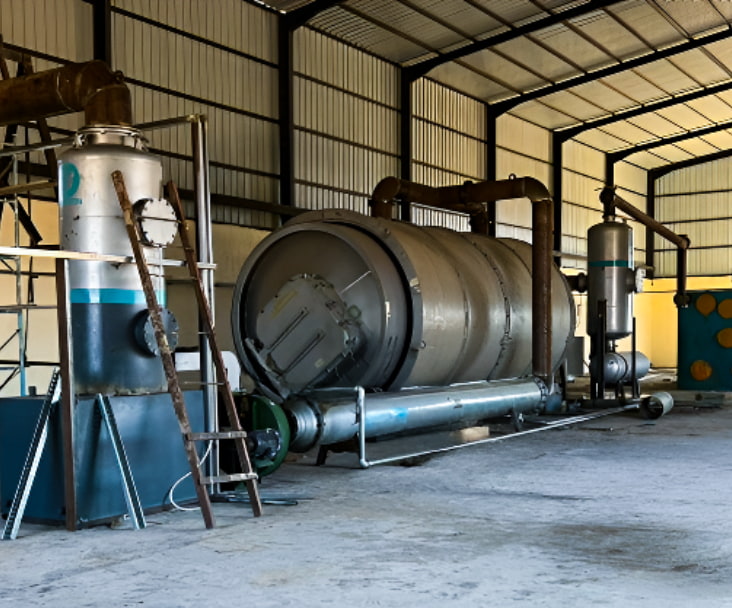In today’s environmentally conscious world, the need for effective and sustainable waste management solutions is more critical than ever. One area where significant strides have been made is in tyre recycling, with pyrolysis emerging as the premier method for transforming end-of-life tyres into valuable resources. Pyrolysis, a thermochemical decomposition process, holds immense promise due to its ability to convert waste tyres into useful products such as fuel oil, carbon black, and steel wire.

The Pyrolysis Process
Pyrolysis involves the thermal degradation of organic materials in the absence of oxygen. This process begins by feeding shredded tyres into a pyrolysis reactor, where they are subjected to high temperatures ranging from 400 to 800 degrees Celsius. Under these conditions, the rubber compounds in the tyres break down into smaller molecules, producing gases, liquids, and solid residues.
Key Components of Pyrolysis
- Gas Phase: This phase generates gases such as methane, ethylene, and hydrogen, which can be used as fuel or further processed into chemical feedstocks.
- Liquid Phase: The liquid fraction primarily consists of pyrolysis oil, also known as tyre oil or fuel oil. This valuable product has a wide range of applications, including heating fuel, industrial feedstock, and diesel blending.
- Solid Phase: Carbon black is the main solid residue produced during pyrolysis. This high-quality carbon material can be used as a reinforcing agent in rubber products, as well as in the production of pigments and electrodes.
Advantages of Pyrolysis for Tyre Recycling
1. Environmental Sustainability
Pyrolysis offers a sustainable solution to the environmental challenges posed by tyre disposal. By converting tyres into valuable resources, pyrolysis reduces the need for landfilling or incineration, both of which contribute to pollution and greenhouse gas emissions.
2. Resource Recovery
One of the primary benefits of tyre to oil plant is its ability to recover valuable materials from waste tyres. The resulting products, including fuel oil, carbon black, and steel wire, can be used as substitutes for virgin materials, thus conserving natural resources and reducing reliance on fossil fuels.
3. Energy Generation
Pyrolysis oil produced during the process can be used as a renewable energy source. With proper refining and treatment, pyrolysis oil can serve as a clean-burning fuel for industrial processes, power generation, and transportation, reducing the demand for traditional fossil fuels.
4. Waste Reduction
Through pyrolysis, tyres are effectively diverted from landfills or illegal dumping sites, contributing to waste reduction and environmental preservation. This not only helps to mitigate the visual and environmental impact of tyre waste but also conserves valuable landfill space.
5. Economic Viability
Pyrolysis presents a viable business opportunity for tyre recyclers, offering the potential for revenue generation through the sale of valuable end products. Additionally, the modular and scalable nature of pyrolysis systems allows for flexibility in plant size and production capacity, catering to varying market demands. You can contact Beston Group Co., Ltd.
to get an accurate ROI analysis.

Challenges and Considerations
While pyrolysis holds immense potential as a tyre recycling solution, several challenges and considerations must be addressed to ensure its widespread adoption and success.
1. Technology Development
Continuous research and development efforts are needed to enhance pyrolysis technology, improve process efficiency, and optimize product quality. Innovation in reactor design, feedstock preparation, and product refinement will drive advancements in the field.
2. Regulatory Compliance
Regulatory frameworks governing waste management and recycling practices vary by region and jurisdiction. Tyre recyclers must navigate complex regulations and obtain necessary permits and approvals to ensure compliance with environmental standards and regulations.
3. Market Demand
The market demand for waste tyre pyrolysis plant products, particularly fuel oil and carbon black, plays a crucial role in the economic viability of tyre recycling ventures. Understanding market dynamics, identifying potential end users, and establishing strategic partnerships are essential for market penetration and product commercialization.
4. Economic Feasibility
The economic feasibility of pyrolysis projects depends on various factors, including capital investment, operating costs, feedstock availability, and product pricing. Tyre recyclers must conduct comprehensive cost-benefit analyses to assess the financial viability of pyrolysis ventures and secure investment funding.
Conclusion
In conclusion, pyrolysis stands out as the best tyre recycling solution due to its environmental sustainability, resource recovery capabilities, energy generation potential, waste reduction benefits, and economic viability. By harnessing the power of pyrolysis, tyre recyclers can contribute to a circular economy, reduce reliance on virgin materials, and mitigate the environmental impact of tyre waste. With ongoing technological advancements and regulatory support, pyrolysis holds promise as a cornerstone of sustainable waste management practices in the tire recycling industry.